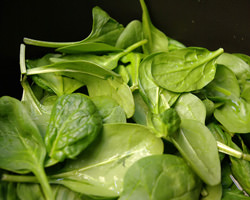
Courtesy University of Kansas/ Shant Thomas
The Farm-to-Cart program gives students at the University of Kansas the opportunity to buy fresh produce from local farms.
When students at the University of Kansas go home for Thanksgiving dinner this year, many might actually eat worse food than they do at school. In the college town of Lawrence, Kan., long gone are the days of freshmen and sophomores subsisting solely on over-processed junk food. Sure, students still can choose from typical college-food options—what’s a student union without a little pizza?—healthier ones are also available, thanks to KU’s Farm-to-Cart program.
Launched in June 2010, the Farm-to-Cart program does exactly what it says: It makes farm-fresh, local foods available on a cart in a food court-like area of KU’s student union called The Market.
“We’ve had local purchasing as one of our goals in our strategic plan for the last few years,” says Nona Golledge, director of KU dining services. “And one of our goals for this year was to implement a farm-to-cart program, start slow, and see how well it was received on campus.”
Due to a rough growing season and the fact that many students and faculty were gone for the summer, the program did indeed get off to a slow start. Still, Golledge says that implementing it was surprisingly easy. The university’s primary food vendor, Sysco, was already partnering with the supplier Good Natured Family Farms, an alliance of more than 100 family farms in the Midwest that certifies and distributes locally grown, pesticide-free foods throughout Kansas and Missouri under its label.
“We were very excited when we found out they had that partnership,” Golledge says. “They were GAP [Good Agricultural Practices] certified. We wanted to make sure food coming to us from local sources was going to be safe.”
Initially, items on the cart were available only on Mondays and Wednesdays and limited to cucumbers from a farm in Rich Hill, Mo., and heirloom tomatoes from a farm in Stanberry, Mo. Now, the cart is open daily and has sold squash, apples, red-leaf lettuce and more. As the harvest season comes to an end and the ground freezes, the cart will carry other locally prepared items, like honey, so it can remain open year-round.
“We’re hoping it really takes off in the next growing season, and we’re looking into placement on center campus or putting up more displays.” Golledge says. As with any product, she emphasizes that to be successful, marketing is key.
“When we really wanted to promote apples and squashes, we pulled the cart out into the center of the food court area and sales went up tremendously,” she says. “Placement of the cart is crucial.”
Even though the cart isn’t selling out of produce just yet, Golledge says it’s been a great avenue for educating the campus about buying local produce. While none of the KU students we were able to reach for this article had visited the cart themselves, they’d all heard of it, and for Golledge, that’s half the battle.
“It’s an avenue for our consumers to be able to purchase fresher produce. But it also helps to educate and create awareness about buying locally,” she says.
Keeping with the idea of sustainability, items that don’t sell during their prime get used in soups and at the salad bar. And a union rooftop garden provides herbs for the university’s catering program.
Golledge also hopes to add more local products into prepared meals for residential dining, as well as the university’s catering services and restaurants. Currently, about 15 percent of the 22 dining locations on campus use or provide local products, including coffee. Her goal is to grow that number by 25 percent. Considering KU’s dining services provide nearly 10,000 meals per day (residential and retail), that’s a number that makes a lot of sense for the university right now.
“It’s difficult for local farmers to provide all of the produce we need,” Golledge says. “So we’re looking at it as progress and every year adding what we can to our operations when it makes financial sense to add them.”














